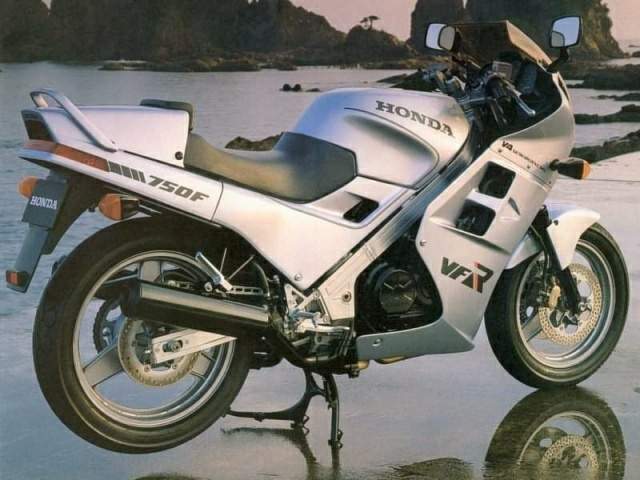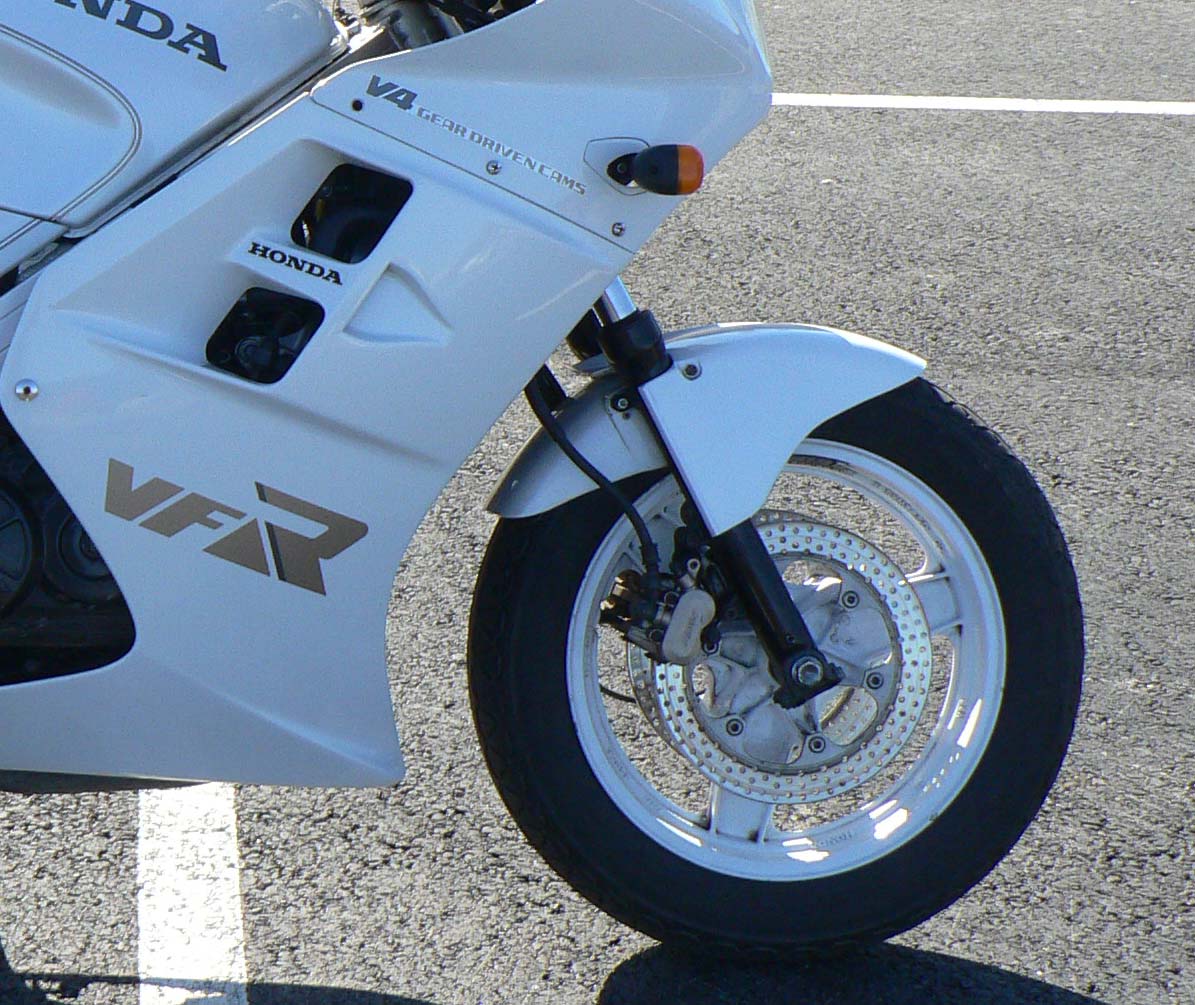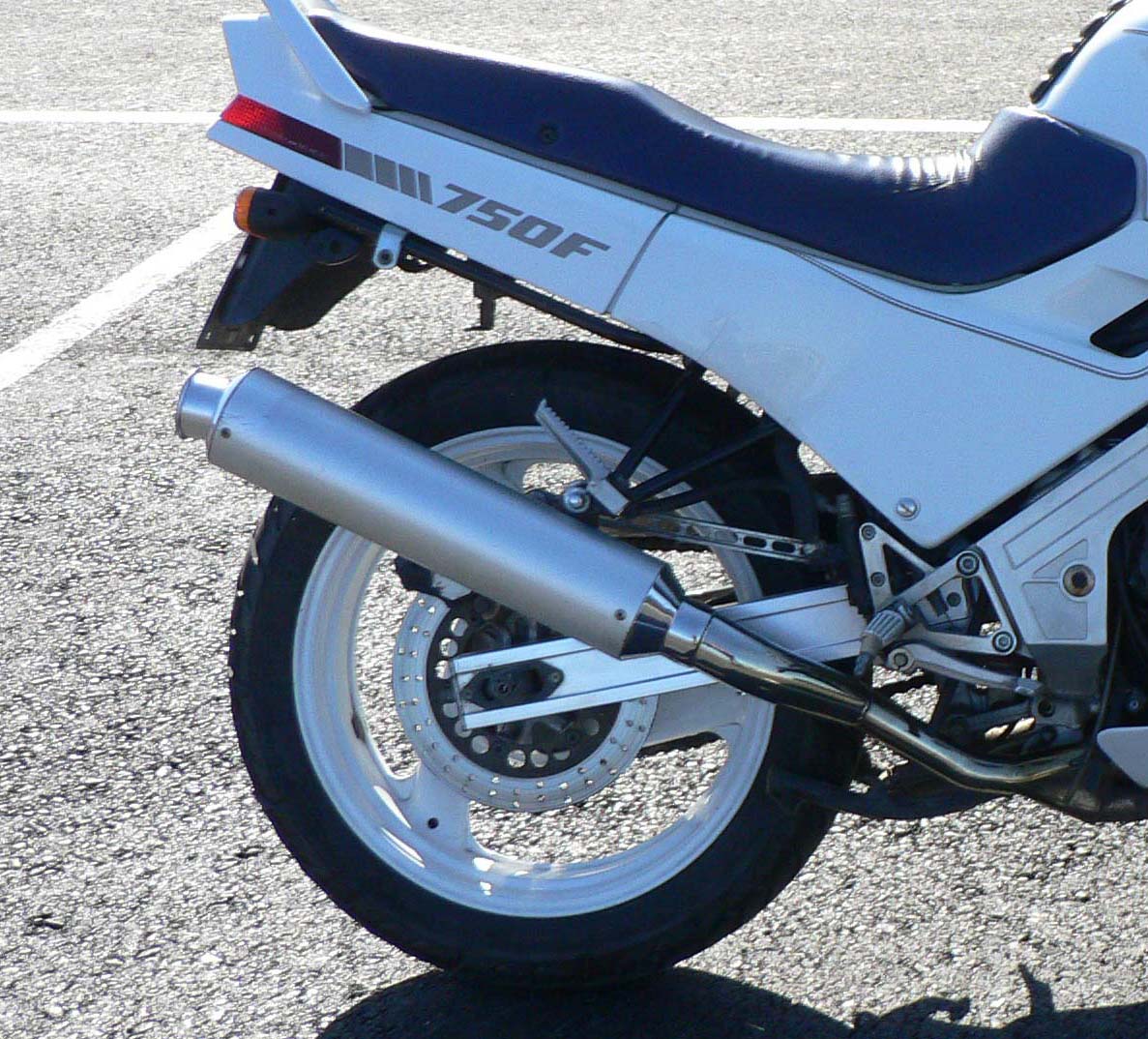
|
|
|
|
|
|
Classic Bikes
Custom Bikes
Individual
Racing Bikes AJP
AJS
Aprilia
Ariel
Avinton / Wakan
Bajaj
Benelli
Beta
Bimota
BMW
Brough Superior
BRP Cam-Am
BSA
Buell / EBR
Bultaco
Cagiva
Campagna
CCM
CF Moto
Combat Motors
Derbi
Deus
Ducati
Excelsior
GASGAS
Ghezzi Brian
Gilera
GIMA
Harley Davidson
Hero
Highland
Honda
Horex
Husaberg
Husqvarna
Hyosung
Indian
Jawa
Kawasaki
KTM
KYMCO
Laverda
Lazareth
Magni
Maico
Mash
Matchless
Mondial
Moto Guzzi
Moto Morini
MV Agusta
MZ / MuZ
NCR
Norton
NSU
Paton
Peugeot
Piaggio
Revival Cycles
Roland Sands
Royal Enfield
Sachs
Sherco
Sunbeam
Suzuki
SWM
SYM
Triumph
TVS
Ural
Velocette
Vespa
Victory
Vincent
VOR
Voxan
Vyrus
Walt Siegl
Walz
Wrenchmonkees
Wunderlich
XTR / Radical
Yamaha
Zero
Video
Technical
Complete Manufacturer List
|
Honda VFR 750F-II-H
|
| . |
|
Make Model |
Honda VFR 750F-II-H |
|
Year |
1987 |
|
Engine |
Four stroke, 90°V-four cylinder, gear driven DOHC with rocker arm, 4 valve per cylinder |
|
Capacity |
748 cc / 45.6 cub in |
|
Bore x Stroke |
70 x 48.6 mm |
|
Compression Ratio |
10.5:1 |
|
Cooling System |
Liquid cooled |
|
Induction |
4x 34.5mm Keihin VD carburetors |
| Lubrication | Forced pressure and wet sump |
|
Ignition |
Transistorized |
| Starting | Electric |
|
Max Power |
77.4 kW / 106 hp @ 10500 rpm |
|
Max Torque |
66 Nm / 6.7kgf-m / 48.7 ft-lb @ 7500 rpm |
| Clutch | Wet multiplate |
|
Transmission |
6 Speed |
|
Final Drive |
Chain |
| Primary Reduction | 1.9393 (63/33) |
| Final Reduction | 2.8125 (45/16) |
| Gear Ratios | 1st 2.8461 (37/13) 2nd 2.0625 (33/16) 3rd 1.6315 (31/19) 4th 1.3333 (28/21) 5th 1.1538 (30/26) 6th 1.0357 (29/28) |
| Frame | Aluminum twin-spar frame |
|
Front Suspension |
37mm Showa air assisted telescopic fork with TRAC Anti-Dive |
| Front Wheel Travel | 140 mm / 5.5 in |
|
Rear Suspension |
Pro-Link adjustable for preload only with remote adjuster |
| Rear Wheel Travel | 105 mm / 4.1 in |
|
Front Brakes |
2x 276mm discs, 2 piston calipers |
|
Rear Brakes |
Single 256mm disc 2 piston caliper |
|
Front Tyre |
110/90 V16 |
|
Rear Tyre |
130/80 V18 |
| Rake | 27.5 ° |
| Trail | 108 mm / 4.2 in |
| Wheelbase | 1475 mm / 58.1 in |
|
Dry Weight |
198 kg / 347 lbs |
|
Wet Weight |
222 kg / 489.4 lbs |
|
Fuel Capacity |
20 Litres / 5.3 US gal |
|
Consumption Average |
5.3 L/100 km / 18.6 km/l / 44 US mpg |
|
Standing ¼ Mile |
11.6 sec / 192 km/h / 119 mph |
|
Top Speed |
237 km/h / 147 mph |
| . |
Mechanically the same as the standard "F" model. The F2 spec received square gauges, an all black engine and less "Ricky Racer " graphics. It sported reworked fork internals and a better rear shock than the '86 VFR750 or the "standard" '87 VFR700. Colors were metallic blue with silver/pewter wheels and stripes or a pearl white w/gold accents.

One look at the top table showed how serious Honda were about this one. There was the man from head office in charge of all things that Honda do in Europe, the marketing manager for Europe, a big noise from HRC, the engineer in charge of the- project, and even the bloke in charge of engineering quality control at the factory, We weren't told whether he had the same job when they were building the earlier 750s, but he didn't say a lot.
Not that anyone was surprised by Honda's attitude to the VFR. Despite the fact that they've won every TT Formula 1 World Championship in living memory and taken two consecutive World Endurance titles with V4s, the small matter of self-destructing top ends not only stopped sales of the afflicted 750s but put the mockers on the VF500 and VF1000 as well. Seeing as how Honda's immediate future success is tied firmly to the V4 configuration both on road and track, this one had better be good.
You won't be surprised to hear that the VFR750 is indeed a very fine machine. We all knew it would be after Honda unveiled it after last year's Bol d'Or, what we didn't know as whether the looks were right.
After all, the Yamaha FZ750 - unquestionably the best machine of 1985 - failed to sell as it deserved to simply because of its looks. Despite the fact that we were told that the VFR is intended to be the 'World's top 750cc super sports motorcycle, with a classy appearance', Honda have chosen to disguise all the race-bred engine and chassis technology with a very restrained combination of glass-fibre and paint.

The track heritage is obvious. Compared to the poor old VF750, the new R is but a distant relative. The crank is now 180, not 360°, the camshafts are gear driven and the valve gear totally new. Rocker shafts have been done away with totally and in their place the rockers pivot on a Rose-type joint in the cylinder head with the clearance by threaded adjusters at the pivot end. The other end of the rocker makes line, not point, contact with the valve stem for improved wear resistance.
The major advantage of doing away with the rocker shafts is that considerable amounts of space are liberated inside the cylinder head. Honda's engineers have used this to make the inlet tracts almost straight and reduce the angle between the carbs by 20° to 52°. The carbs are now 34mm bore as opposed to 32. All reciprocating parts are considerably lighter than in the VF, resulting in a weight saving in the motor alone of around ten per cent.
The frame follows race practice closely. It's a diamond type using the engine as a stressed member and uses both extrusions and castings. Box-section tubing measuring 28 by 60mm joins aluminum castings at the steering head and engine mountings at the back of the gearbox. The downtubes are 30 by 40mm and the whole thing weighs just 14kg.
Brakes and forks are also smaller and lighter. Honda claim to have lost 2.6kg off the braking system alone. The surprisingly small Nissin calipers use very thin pads with a new ceramic spray coating on the back of the backing plates to cut down on heat flow into the brake fluid. The basically sintered-metal friction material also uses a significant amount of ceramic in its mix.
Despite Honda's emphasis on the VFR as a road bike, they took us to a race track to ride it. First sight of the line up of bikes in the pits at the new Jerez track in southern Spain was something of a shock. The bike looked a lot better than it did on a podium in a show, although one or two cynics remarked that it'd look good when they finished it and put on a coat of paint.
The same could be said of the track, only more so. Although the tarmac was finished the rest of the place was one big building site and heavy rain had washed surplus sand, mud and other debris all over the surface. There were also a couple of mini-rivers running across it.
After a suitable period of panic, we were allowed out. I picked one of the white bikes and promptly scared myself so thoroughly that I came in and hid for a while. Not only did I forget about the Honda mechanic's warning about a new tyre being fitted and get a bit sideways the first time I went faster than walking pace, but the front end showed a horrible desire to wash out. When one Brit went down in a heap at a speed only slightly above my own snail's pace my paranoia promptly went out of control.

Half an hour later reluctance to appear totally chicken overcame my fear and I wobbled out on a blue bike. The difference was astounding. Despite the fact that they were all supposed to be set-up the same, this bike was much better in all departments. Perhaps the heavy footed attentions of Italians, French and Germans on previous days had taken their toll. Incidentally, the bikes were from the first run down the production line that Honda use to check that everything is okay.
This time I managed to remember which way the corners went. When they finish the Jerez circuit it's going to be superb, it's rather like Rijeka in Yugoslavia crossed with Brands Hatch in that the only straight worthy of the name is the start-finish and the rest is about 4km of fast and slow bends with what look like lots of well-placed stands going up ready for the car GP in April. Once I got back to the pits and released my death grip on the bars I realised I liked the circuit but knew next to nothing about the bike except that it was incredibly tractable and the brakes were amazing.
Thankfully, the combined attentions of UK, Dutch, and Scandinavian journalists got the track well swept by mid-afternoon, although the right-hander that had caused the embarrassing second-lap stack and at least one other were still horribly slippery.
One of the cross-track rivers dried up as well. Fear of having to invent something to say about the bloody bike sent me back out on the favoured blue machine and suddenly things started coming together. The brakes are unbelievably strong and sensitive. It's possible to grab a handful and stop instantly or use the sensitivity and progression to be a bit more subtle.
I was starting to find the lines and get into and through the corners a hell of a lot faster than in the morning. The bike seemed happy to do anything I wanted, even when I did the classic race track novice's trick of getting dramatically quicker through one corner without working out what to do when I arrived at the next corner considerably faster than the last time around.
At first I thought the bike was close to an FZ, but it turned out to be subtly different in just about every way except for low-down tractability. Dragging the motor out of slow corners from as low down as 4500 to 5000rpm produced a beautiful noise one onlooker likened to two V-twins. Which is exactly what it is. When the tacho hits somewhere just under 7500rpm things start happening very rapidly, but it is the strength of the top end power that is really impressive. It was worth changing up even for Jerez's short straights as the power to pull the higher gear was always there.

Compared to the FZ, the VFR is like an armchair. I managed to raise a sweat (most of it cold) without getting aching wrists or a pain in the bum. This could be the one for that long winding road if you want to be able to walk at the other end. The FZ's adequate in that department, the GSX-R dreadful.
Apart from the gearbox problems that afflicted one bike, the only problems reported were by the really fast guys who reckoned the forks needed bracing to cope with really rapid changes of direction and the single-sided TRAC anti-dive. I think I noticed a bit of fork walk once, but then again...However, I can't say I like the idea of the abilities of this bike without a fork brace, especially once there are a few thousand miles on the clock and the clearances in the head bearings and fork sliders are opening up a bit. The only other question raised was about the high-tech ceramic backed brake pads. Did they preclude the fitting of 'normal', uncoated after-market pads and would the real thing be more expensive than normal. The answers were 'Probably, but we always recommend the fitting of genuine Honda parts,' and 'Yes.' However, the original pads should last at least 25 per cent longer than normal equipment.
Honda have unquestionably achieved their ambitions. They've built a bike using a lot of the experience gained from Fl and Endurance world championships but stopped short of making it a race-replica in the way we understand that phrase. Not enough people buy 'em, you see, so all the Joey Dunlop replica technology is hidden away beneath the sober exterior. But the bike's looks belie its performance. You can drive it low down on the torque or on the power of the very strong top end; the choice is yours. Whichever way you want to do it, you'll do it in comfort.
Which just leaves us with the small matter of public confidence in the V4. Only time will tell if the VFR's manifold good points are enough to overcome the suspicion that the first two VFs created.
Source Motorcycle International 1986

|
Any corrections or more information on these motorcycles will be kindly appreciated. |